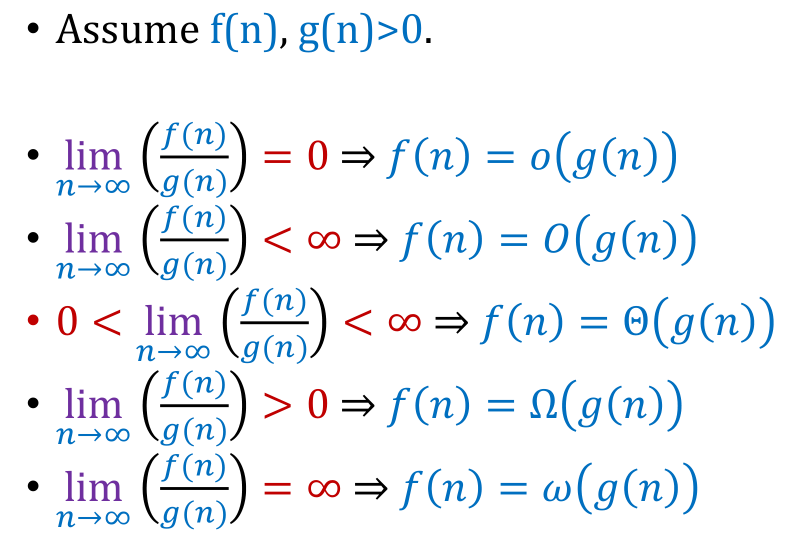
$\require{color}$
In the previous topic we went through the comparison and query models. These models had comparisons and queries respectively as the basic operational unit for their algorithms.
For the rest of the module we use the Word RAM model. This model assumes:
Input size: Depends on the problem. Can be either
Running time: counted by the number of basic instructions.
For any $n > n_0$, \(f(n) = O(g(n)) \Leftrightarrow 0 \le f(n) \le cg(n) \quad \text{for some } n_0, c>0\)
Meanwhile o-notation is a tighter restriction: \(f(n) = o(g(n)) \Leftrightarrow \text{for \textcolor{red}{any} } c>0, \quad 0 \le f(n) \textcolor{red}{<} cg(n)\text{ for some $n_0$ and } n > n_0\)
For any $n > n_0$, \(f(n) = \Omega(g(n)) \Leftrightarrow 0 \le cg(n) \le f(n) \quad \text{for some } n_0, c>0\)
Meanwhile $\omega$-notation is a tighter restriction: \(f(n) = \omega(g(n)) \Leftrightarrow \text{for \textcolor{red}{any} } c>0, \quad 0 \le cg(n) < f(n) \quad \text{for some $n_0$ and} , n > n_0\)
or in other words,
\[f(n) = \Theta(g(n)) \Leftrightarrow 0 \le cg(n) \le f(n) \le dg(n) \quad \text{for some } n_0, d > c >0\]
Theorem. Show that $f(n) = o(g(n)) \Leftrightarrow \lim_{x \rightarrow \infty}\frac{f(n)}{g(n)}= 0$.
Proof. Given $\lim_{n \rightarrow \infty}\frac{f(n)}{g(n)}= 0$, for all $\epsilon > 0$, we have $\delta > 0$ such that
\[0 < \infty - n < \delta = \infty \Rightarrow \frac{f(n)}{g(n)} < \epsilon \Rightarrow f(n) < \epsilon g(n)\]Setting $c = \epsilon$ and $n_0 = \delta$, we get for any $c > 0$, there is $n_0 > 0$ such that $f(n) < cg(n)$, which means by definition, $f(n) = o(g(n))$.
Similar argument can be made for rest of the statements.
Similar for other notations ($\Omega, \omega, o, \Theta$)